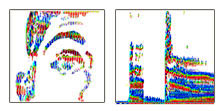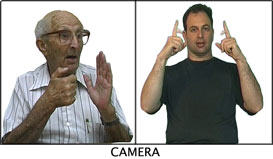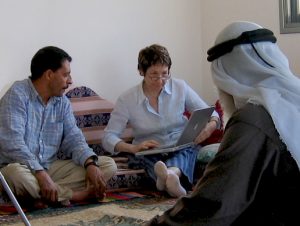![]()
Signs in sign languages have internal morphological structure, like words in spoken languages. Yet sign languages favor a specific type of morphology, the simultaneous, non-concatenative type. Verb agreement is an example. By applying a particular componential analysis of verbs in ISL, Irit Meir develops a model which can predict the agreement pattern of each verb in ISL and other sign languages, and, at the same time, can pinpoint the similarities and differences between the spatial predicates of ISL (and sign languages generally) and the auxiliary and verb systems of spoken languages.
By examining both the common non-concatenative type of sign language morphology as well as the rare but attested sequential affixation in these languages, our work identifies properties that make sign language a morphological type.
In addition, studies of the lexicons of sign languages elucidate the intricate ways in which sign language word formation interacts with iconicity, showing how iconic expression contributes to the emergence and development of linguistic structure.
Publications:
Meir, Irit (2012). ‘Word classes and word formation’. In: R. Pfau, M. Steinbach and B. Woll (Eds.). Handbook on Sign Language Linguistics. Berlin: Mouton De Gruyter, 365-387.
Meir, Irit (2010). ‘Iconicity and metaphor: Constraints on metaphorical extension of iconic forms’. Language, 86(4), 865-896.
Meir, Irit, Mark Aronoff, Wendy Sandler and Carol Padden (2010). ‘Sign languages and compounding’. In: S.Scalise and I.Vogel (Eds.). Compounding. John Benjamins, 301-322.
Padden, Carol, Irit Meir, Mark Aronoff and Wendy Sandler. (2010). ‘The grammar of space in two new sign languages’. In D. Brentari (Ed.). Sign Languages: A Cambridge Survey. New York: Cambridge University Press, 573-595.
Meir, Irit (2007). ‘The morphological realization of semantic fields’. On-line proceedings of TISLR 9 conference, Florianopolis, Brazil.
Meir, Irit, Padden, Carol, Aronoff, Mark, and Sandler, Wendy (2007). Body as subject. Journal of Linguistics, 43, 531-563.
Meir, Irit, Carol Padden, Mark Aronoff and Wendy Sandler (2007): Re-thinking Sign Language verb classes: The body as subject. On-line proceedings of TISLR 9 conference, Florianopolis, Brazil.
Aronoff, Mark, Irit Meir and Wendy Sandler (2005). ‘The paradox of sign language morphology’. Language, 81(2), 301-344.
Aronoff, Mark, Irit Meir, Carol Padden and Wendy Sandler (2004). ‘Morphological universals and the sign language type’. In: G. Booj and J. van Marle (Eds.). Yearbook of morphology. Dordrecht/Boston: Kluwer Academic Publishers, 19-39.
Aronoff, Mark, Irit Meir, Carol Padden and Wendy Sandler. (2003). ‘Classifier constructions and Morphology in Two Sign Languages’. In K. Emmorey (Ed.). Perspectives on Classifiers in Sign Languages. Mahwah, New Jersey: Lawrence Erlbaum Associates, 53-84.
Meir, Irit (2002). ‘A cross-modality perspective on verb agreement’ Natural Language and Linguistic Theory, 20(2), 413-450.
Meir, Irit (2001a). ‘Motion and Transfer: The analysis of two verb classes in Israeli Sign Language.’ In V. Dively (Ed.). Signed Languages: Discoveries from international research. Washington D.C.: Gallaudet University Press, 74-87.
Meir, Irit (2001b).‘Verb classifiers as noun incorporation in Israeli Sign Language’, Yearbook of Morphology 1999, 295-315.
Aronoff, Mark, Irit Meir and Wendy Sandler (2000). ‘Universal and Particular Aspects of Sign Language Morphology’. University of Maryland WPL 10, 1-33.
Meir, Irit (1998). Thematic structure and verb agreement in Israeli Sign Language. PhD dissertation, Hebrew University of Jerusalem.
Meir, Irit (1998). ‘Syntactic-Semantic Interaction in Israeli Sign Language verbs: The Case of Backwards Verbs’. Sign Language and Linguistics, 1, 3-33.



